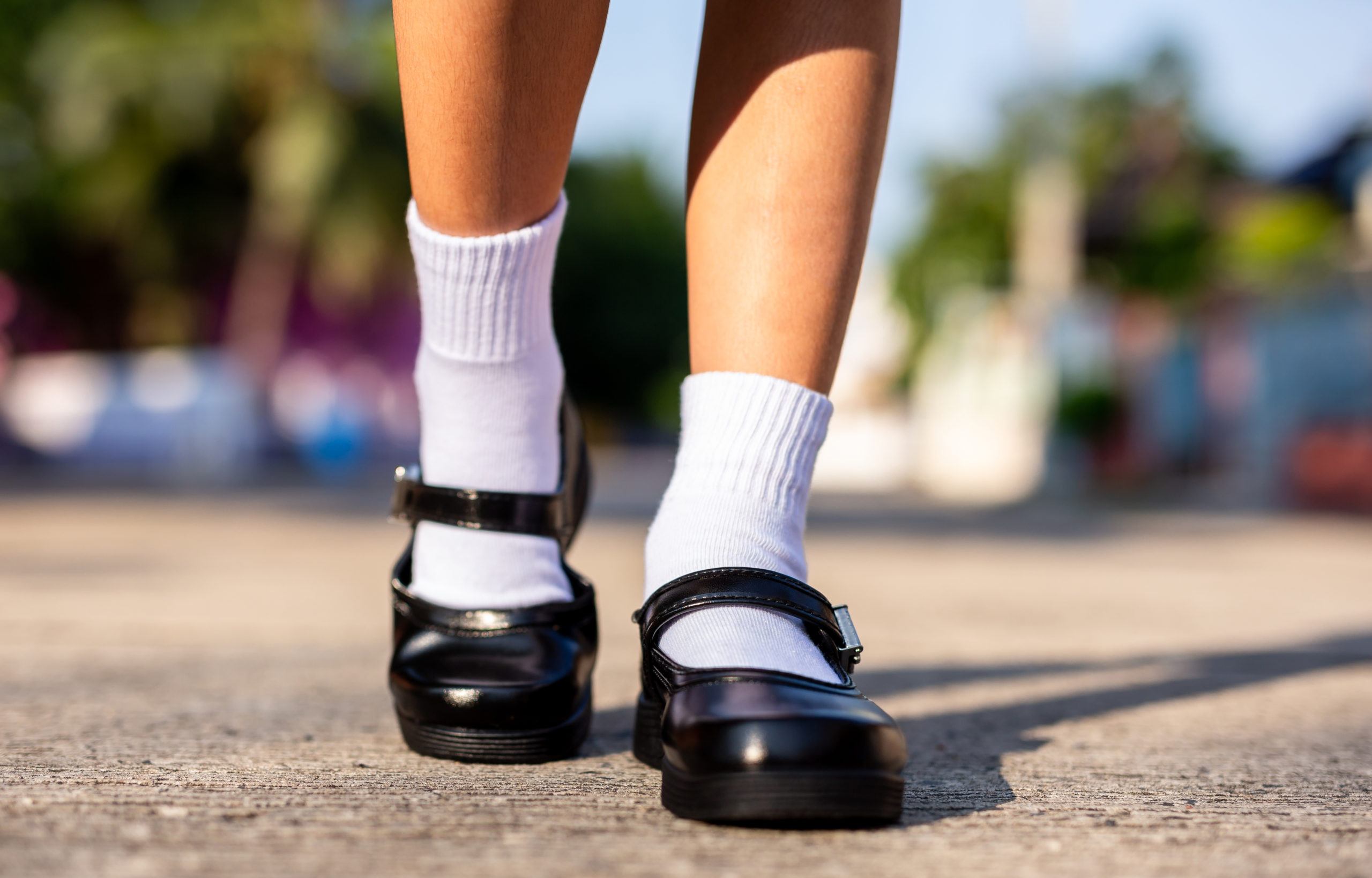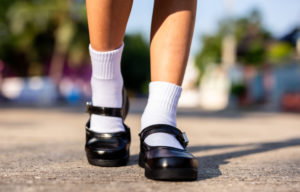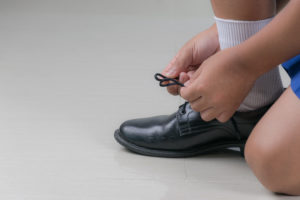
 Your child’s school shoes will help them put their best foot forward for the new 2021 school year! So don’t take chances – follow this handy guide to help choose the best shoes for your kids.
Your child’s school shoes will help them put their best foot forward for the new 2021 school year! So don’t take chances – follow this handy guide to help choose the best shoes for your kids.
Keep in mind:
- School shoes aren’t just a ‘uniform requirement’ set out by the school. Good shoes have the potential to reduce injury risk, promote foot health, prevent tired and achy legs at the end of the day, and prevent a number of foot problems like bunions and hammertoes
- When shoes cause pain, it can throw off your child’s concentration and their mood, affecting them much more than we may realise at school
- As kids grow and change, their feet do too. Shoes that were suitable for our kids a year ago may not be so now, as their feet and support requirements may have changed significantly
- Kids will spend at least 1200 hours in school shoes every year. This gives shoes a lot of power and influence over foot health and comfort. Yet research by Australia’s largest podiatry group, My FootDr, has previously revealed that a staggering 61 per cent of children haven’t had their feet properly measured or fitted within the last 12 months
- A survey of 2109 parents showed that 65% did not correctly identify their children’s shoe sizes when compared against accurate foot measurements for the kids. Moreover, some kids were found to be wearing shoes up to two sizes too small
Felt a little unsettled when reading the above information? Don’t worry, we did too. The good news is that buying school shoes does not have to be complicated when you know what to look for. Here’s what you should be keeping an eye on when buying new shoes for your child:
1. What ‘the right fit’ really means
Having the right shoe fit can reduce the risk of many problems developing, both short-term like blisters and corns, and long-term like bunions and curly toes. If the shoes are:
- Too short or narrow – this can create high-pressure areas on the bones of the feet, and the skin protecting the toes. This rubbing and friction is often the cause of many children’s foot pains and problems
- Too long or broad – this causes the toes to claw at the base of the shoe as kids grip the shoe to get more stability, and may cause trips and falls (and subsequently other injuries)
- Do not match the natural shape of the child’s foot – this is an indicator that they will be vulnerable to excess rubbing, pressure and pain
Resist the urge to buy shoes that are sized too big for your children’s feet. It’s a common misconception that allowing your children to ‘grow into’ them will prolong the use of the shoes, where in fact, shoes will wear out and scuff as your child drags them along the ground, wearing the soles thinner, faster.
Children’s feet grow on average 1-2 sizes per year, so it’s important to have their feet measured before buying new shoes. Always have the shoes fitted for both length and width. When measuring their feet, make sure your child is standing as the foot elongates with weight-bearing. Bring along their school socks to make sure the shoes fit comfortably, and try shoes on at the end of the day to account for the natural swelling that occurs throughout the day.
2. Adjustable fastening is a foot-saver (Laces/Velcro/Buckle)
 Having shoes with an adjustable fastening mechanism like laces, velcro or a buckle is a better option than a slip-on, even if it’s a jogger. A good fastening mechanism:
Having shoes with an adjustable fastening mechanism like laces, velcro or a buckle is a better option than a slip-on, even if it’s a jogger. A good fastening mechanism:
- Secures the shoe to the foot so the toes do not claw to grip the shoe
- Allows you to adjust the shoe when your child grows
3. The heel counter matters, a lot
The heel counter is the rear part of the shoe that wraps around the back of the heel. Your child’s school shoes should have a strong deep heel counter with firm support on either side of the heel. This is important because the heel must be held in a stable position so that it doesn’t lean in (pronation) or out (supination), which could potentially lead to pain and posture problems. Make sure that:
- You aren’t able to pinch or squeeze the sides of the back of the shoe together (because the heel counter is firm)
- If your child is wearing sandals, they have an enclosed back
4. The shoe is reinforced at the shank
The shoe shank is the firm reinforcement that is added to the middle of the sole of the shoe. It helps support the foot and helps prolong the life of the shoe.
Your child’s shoe should naturally bend just before the toes, as this is where the bones in our feet bend as we push off to take the next step. The shank does not extend to this region. Shoes should not, however, be able to bend easily through the middle of the shoe, just as our feet naturally do not bend there.
5. The shoe has some cushioning and arch support
As kids tend to lead a very active lifestyle, a cushioned heel will absorb shock and protect their young joints. Shoes with thick soles and arch support will make it less painful for them to stand or walk. Arch supports can distribute pressure more evenly across feet, protect the foot structures of the feet like ligaments and joints.
6. The shoe is relatively lightweight
The heavier the shoe, the harder the feet, legs and muscles must work to support daily living – and the faster the muscles will tire. Opt for shoes that are lightweight, especially when muscle strength is still developing in younger kids.
7. The shoes are made from good materials
School shoes should be made from a quality breathable material such as leather, which keeps active, sweaty feet in a breathable and water-resistant environment, helping to reduce the risk of fungal infections, blisters or smelly feet! Moisture-resistant and breathable materials absorb internal moisture and limit the amount of external moisture that gets into the shoe, waterproof materials tend to trap sweat, and other materials allow too much external moisture into the shoe.
A good quality pair of school shoes should also have a strong rubber outsole, and a quality shock absorbing midsole to allow kids to be active all day in comfort.
Tips for choosing the best shoes
There is no one shoe brand that will address all of these characteristics nor is there one shoe brand that fits all children – every child’s feet are different! So it’s important to assess each individual shoe on these merits. Don’t be misled by the price either – expensive shoes aren’t necessarily any healthier for your child’s feet.
- Regularly check the size of your child’s socks for appropriate fit – every school holidays
- Get your child’s feedback – allow them to walk around as much as possible in the shoe and feel for pinches and seams
- Children’s socks tend to be forgotten about when considering shoes, however, wearing socks which are too small can apply excess pressure to the toes and may cause them to claw
- As our feet can slightly increase in size throughout the day, take kids shoe shopping with you towards the end, as opposed to the start of the day
- Always look at the fit of both feet in the shoes, as most people have one foot that is slightly longer than the other, and your child may have a toe that isn’t the big toe that is the longest – in which case you want to measure the length to this toe
- While at the store, place the shoes on a flat surface and look at them from behind, looking for irregularities in the heel counter. You should do this for all footwear; even expensive shoes can have manufacturing faults. If they’re not symmetrical and even, give them back to the shoe salesperson and ask for another pair. Do not purchase the shoe until you’re happy, as you should never feel pressured
- Shoes shouldn’t be purchased to be ‘worn in’ – you should have the right fit at the store. Wearing them in around the home can help make the leather softer and more pliable, but it should never influence whether the shoes are the right fit or not
- Toenail length can have an influence on shoe comfort and fit, so keep your child’s toenails trimmed
- If your child wears orthotics, bring them when trying on shoes to ensure there is sufficient depth to fit the orthotics comfortably
- Having your shoes fitted by a trained professional can make a big difference to your child’s foot health and comfort in their shoes
- No foot pain is ever normal for kids, not even ‘growing pains’ – if your child is in any pain, they need their feet and legs checked immediately
Still uncertain about which shoes to go for?
Have your child’s shoes professionally fitted by a podiatrist. Many My FootDr clinics offer a range of footwear that support your family’s feet. Our experienced podiatrists professionally fit each pair to ensure the best fit, and suitability for any problems you may have.
Check here to find your closest My FootDr clinic that offers footwear.


